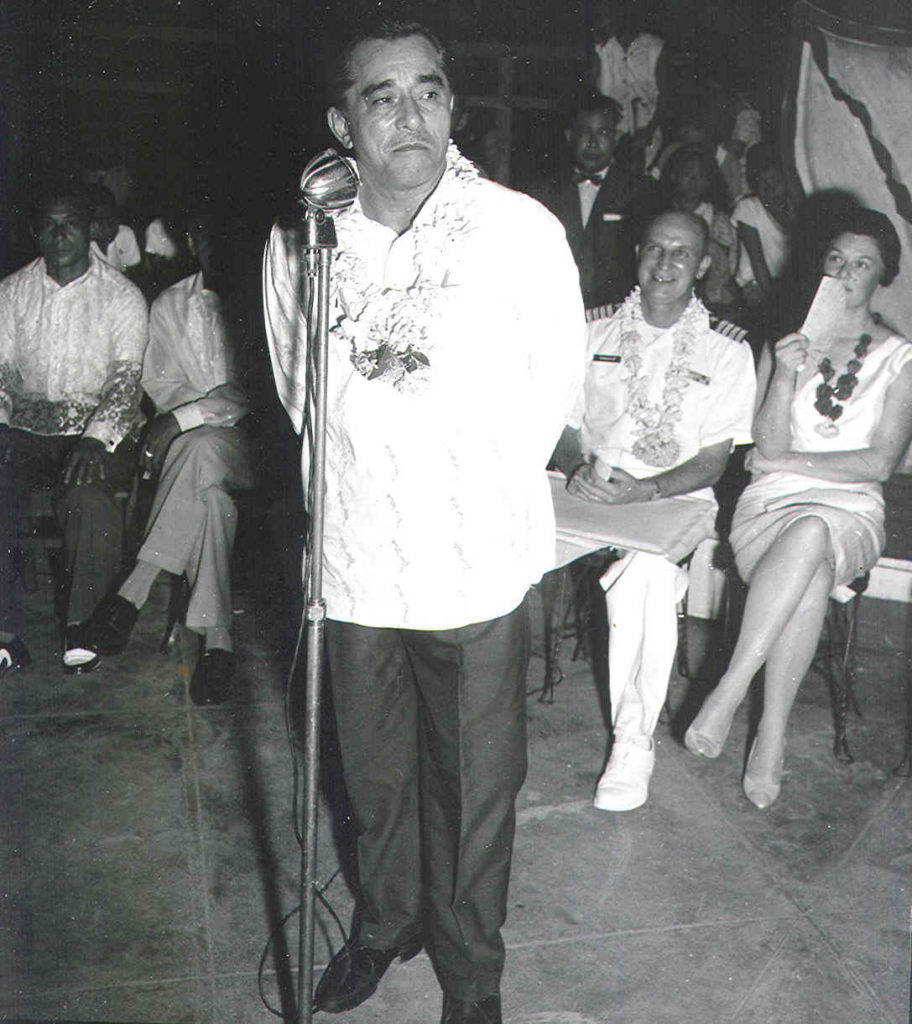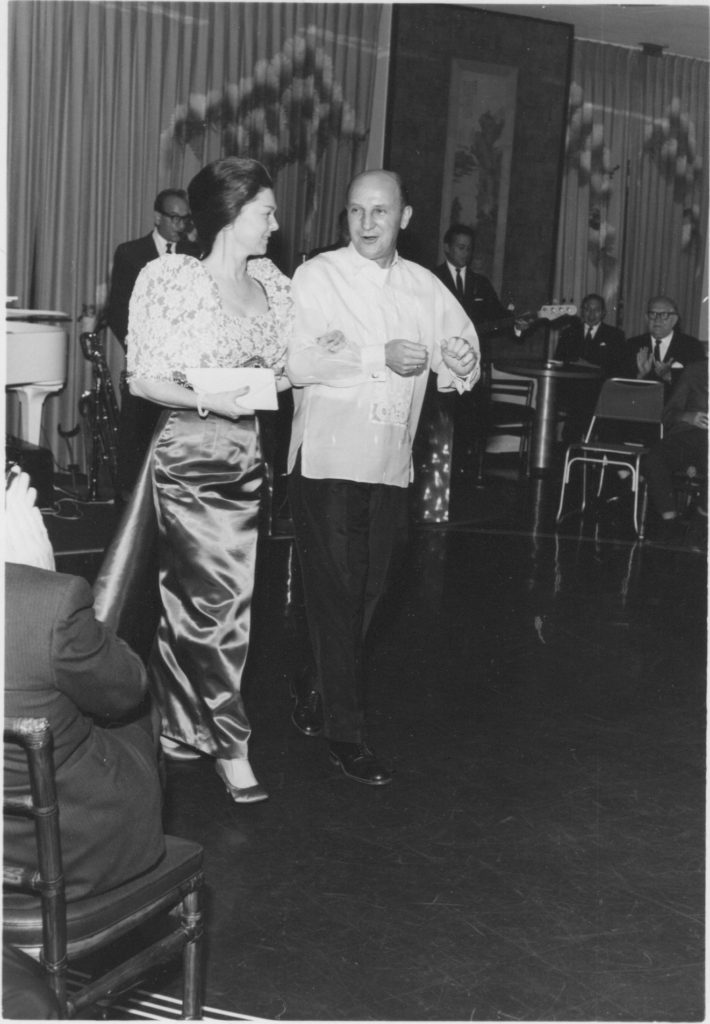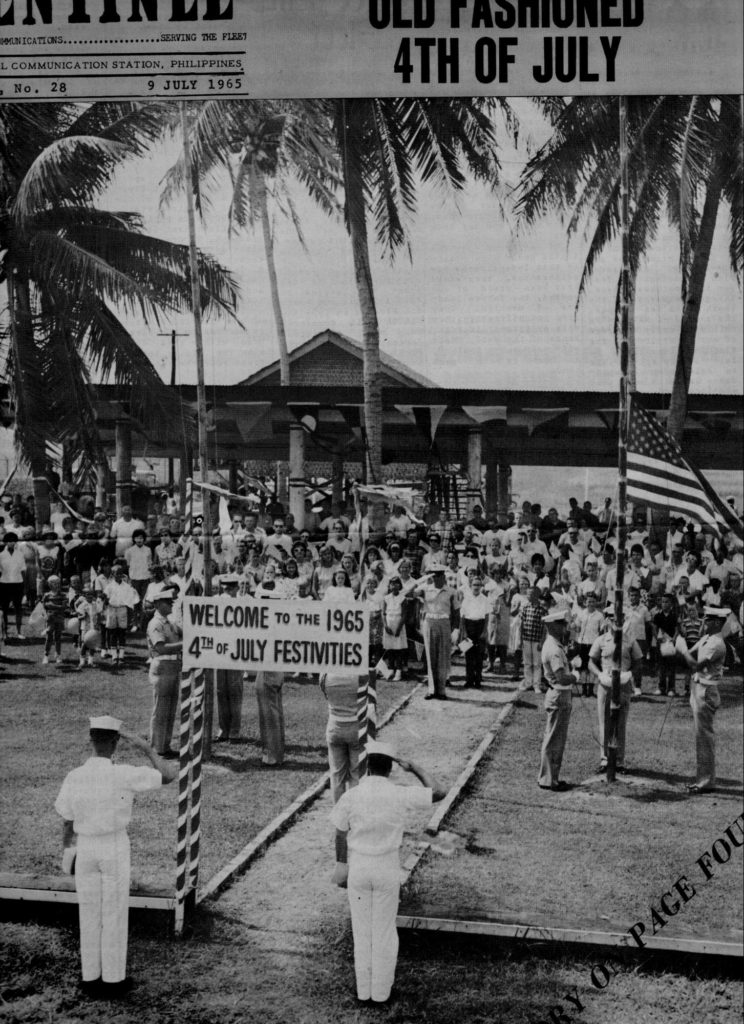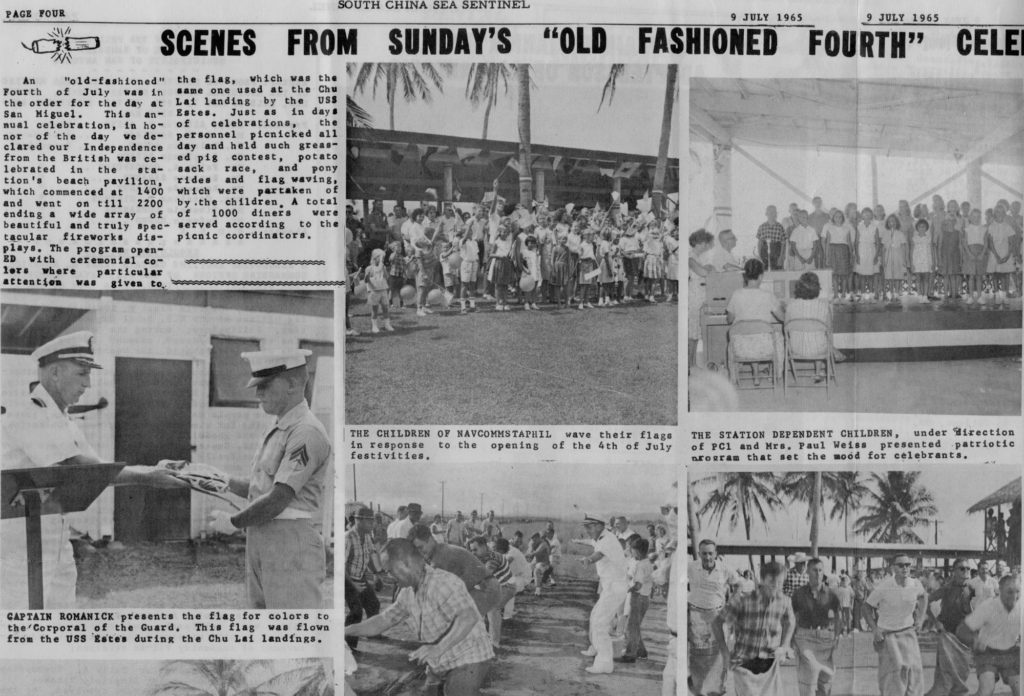by Suzanne Lainson 66
My family and I arrived at San Miguel the first week of September, 1964. My mother and I had never lived overseas before, though my father had years of sea duty which included international travel.
In preparation for moving to San Miguel, we got all our vaccinations at the clinic on our small Navy base in Omaha. I recall typhoid, typhus, and yellow fever.
My parents told me my high school was a long bus ride away and that I’d probably need to be up by 6 AM every morning to get ready for it. While that was earlier than I had ever gotten up for school before, I was happy that I wasn’t going to be sent to a DoD boarding school like some military brats in Europe had to attend. In other words, rather than being bummed out that I had to make that bus ride, I was grateful to be able to live at home.
We drove to San Francisco and there caught the President Roosevelt, a commercial cruise liner, to take us and our cat to the Philippines. It was a 21 day trip. We stopped one day in Hawaii, one day in Japan, and one day in Hong Kong on our way to Manila. The ship was all first class. Quite luxurious, but by the end of it, I just wanted a hamburger.
There was another Navy family on the ship headed for Subic. I don’t know if there were any other military families on the ship being transferred to the Philippines.
On the drive from Manila to San Miguel, I noticed that the air wasn’t heavy with tropical flower scents, as I expected. I assumed all tropical countries would be just as they were portrayed in the movies and on postcards. But what I saw on the drive was more typical of a Third World country than a paradise.
What I remember most about my arrival at San Miguel was the friendliness of the other kids. Seems like everyone came over to introduce themselves. That was great. I felt totally welcome, even though an incompetent hairdresser at Treasure Island in San Francisco had given me the worst haircut in my life before we left and I looked like a total geek. I was so embarrassed by my looks at that time that when I got my yearbook with a photo of me in that wretched haircut, I pasted over it.
The bus ride back and forth from GDHS to San Miguel was the heart of our existence there. There were about 30 of us who made that commute every school day. (I read that later, at some point after I moved away, there were two school buses making the daily trip.) It was a great bonding experience. Even if we didn’t all collect at the same place in the evenings, weekends, and vacations (though many of us did), we were together for about two hours a day on that bus.

Kids getting on the GDHS school bus near my house.
(Photo from Chris Hahn, GDHS 1969, taken either in the fall of 1965 or the spring of 1966.)
It typically got rowdy. It was like a traveling locker room. Lots of humor, some of it a bit off-color, but nothing too shocking. The humor was mostly self-directed. Kids became clowns rather than picking on others.

A typical day on the San Miguel school bus.
There was a lot of movement on the bus. Kids standing up. Kids throwing stuff. Kids lying across seats to take a nap if there was room. There were never any assigned seats and kids didn’t stay in the ones they took.
There were some couples on the bus (one couple in particular got pretty hot and heavy in the very back seat), but most of the students were more likely to sit with their friends than with a boyfriend or girlfriend. The older girls mostly weren’t dating anyone on the bus anyway, and the younger kids hadn’t started dating. And the couples that did form tended to be short-lived because one of them would move back to the States.
When we weren’t on the bus, we’d gather at the beach, the pool, the gedunk, the outdoor theater, or the teen club.
The beach wasn’t glamorous at all, but we all lived within walking distance of it, so it was easy to get to.

The walk to the beach went through this coconut grove.
(Photo found online.)
There were no recreational facilities there. As I recall, there was a floating platform you could sit on if you swam out to it. But otherwise, there was just the lifeguard’s chair and, on the base side of the fence, was the nipa hut. That was a small bar on stilts with a porch where you could sit and watch the waves. I don’t recall hanging out there with my friends. But I do remember walking down there sometimes late in the afternoon, getting a Coke, and watching the sun go down over the water.

The nipa hut by the beach
(Photo found online. Photo taken by Pete Parpan, March 1968.)

(Photo found online. Taken by Bill Spofford.)
The problem with the beach was that it was closed to us during the summer. That was rainy season and pollution washed into the water, so it wasn’t considered safe to swim. Therefore we could spend Christmas vacation at the beach, but not summer vacation.
A few miles off-shore were the Capone Islands. You could hire a local boat to take you out there. I went at least twice, once with a group of friends for my birthday, and once with a teen club group. The snorkeling there was quite good. I didn’t realize how good until I went to the Bahamas once and there wasn’t nearly as much to see. I’ve seen mention on the Internet that the Capones are one of the best snorkeling places in the world.

The San Miguel beach with the Capones in the background.
(Photo by Aron Cook, who was stationed at San Miguel 1967-8.)
When I was at the beach, I spent more time sitting on the sand, listening to the radio and talking to friends than actually swimming. One boy had a surf board and surfed, but no one else did that I recall. I think it was because you couldn’t get them locally, so if you didn’t bring one with you from the States, you didn’t have one.
When we couldn’t go to the beach, and when there wasn’t enough time (like after school), we hit the pool. There was only one base pool, so everyone went there. That meant we could hang out with sailors if we wanted. Usually there was a mix of younger kids, teens, and sailors playing volleyball in the water. It was a good way for everyone it have some physical contact in a non-sexual way. Everyone could jump on everyone else: a welcome opportunity for little kids who wanted to roughhouse, for sailors who were away from their friends and families, and for teen girls to mix with sailors without implying anything. It was more like someone’s backyard pool party than a wild beach blanket bingo between sailors and dependent girls.

The San Miguel pool.
(Photo by Aron Cook, who was stationed at San Miguel 1967-8.)
There was a snack bar at the pool, so we could grab something to eat there. But the preferred eating spot on base was the gedunk. You could get homemade french fries with the skins still on. I’ve never had better french fries in my life. I think they may have cost quarter for a serving.
The teen club was tiny. It was in its own building, but wasn’t much bigger than someone’s living room. It was open on Friday and Saturday nights so most of the base teens gathered there. There was usually an age-appropriate movie followed by dancing to music in the jukebox. The songs there didn’t get updated until someone had new ones from the States and was willing to donate them.

The San Miguel teen club.
Basically it was just this room. There’s the jukebox in the corner and out of view of this shot is a pingpong table.
The other night time gathering spot was the outdoor theater. There were always two movies shown each night. The theater was open to everyone, so that’s where teens and sailors could mix if they wanted to. Some of the girls were dating sailors, so they would join them there if the sailors were off-duty. Most of the teens at the theater didn’t really come to watch the movies. We’d hang out around the edges of the seats and talk. The theater was a short walk from my house so I was there quite often. What I got in the way of American culture came from the movies and from the radio. I don’t think I turned on the TV the entire two years I was in the Philippines.
I rarely got off base other than the school bus to Subic. My parents made a point of saying I wasn’t allowed to freely wander off-base. I’m not sure I ever went to the marketplace outside of San Miguel (maybe once with a friend to buy fabric for a prom dress), and I only got to the marketplace in Olongapo once. I was more likely to do my shopping in Manila when I went with my parents, or when our teen club made a group trip to Manila. Shopping with my mother usually involved buying fabric to be made into dresses by the seamstress who came to our house every week. Shopping with the teens usually meant buying the latest Beatles album because they were always more available in the market than at the exchange. And a plus was that they were the British editions, which had more songs than the American editions. Only years later did I realize that the Beatles albums I bought in the marketplace were probably bootleg versions because the album covers fell apart so easily.
San Miguel had a small exchange which I went to often to buy the latest fashion magazines from the States, to get my film developed, and to see if any decent albums had come in (rarely). I went to the Subic exchange, but not often. I got to the Clark exchange even less.

(Photo found online. Taken by Bill Spofford.)
Teens at San Miguel had a more limited interaction with GDHS students than those who lived in Subic and Cubi. Because it was so far away, we tended not to get to Subic on a regular basis on weekends and vacations. I’d stay after school and spend the night with a Subic or Cubi friend if there was a GDHS dance or other event I wanted to go to, and I got to the Subic teen club a few times, but San Miguel teens tended to have entirely different social lives than those who lived at Subic and Cubi. That was a bummer for me in that some of my best friends lived at Subic and Cubi, but it also meant I developed close friendships with those who did live near me. I don’t remember calling Subic friends from San Miguel. I don’t know if it was that the bases didn’t have easy phone access for non-busy calling, or if I just didn’t call.
At lunch at GDHS, many of the San Miguel kids ate together, so we were sort of our own clique, but not a “cool” clique. I don’t think any of us were considered GDHS’s most popular kids, but we did have each other, so I don’t think any of us felt like losers, either.
When my parents and I arrived at San Miguel it was one month after the Gulf of Tonkin incident, so war activities picked up considerably while we were there. I think all of us teens knew the sailors’ schedules, and we saw them go from an eve-day-mid schedule (8 hours on, 8 off, 8 on, 8 off, 8 on, and then 32 off) to a port-and-starboard schedule (12 on, 12 off). Everyone had a security clearance and they couldn’t tell you what they did. I knew that servicemen were either radiomen, communications technicians, or guard marines. I didn’t know until recently that communications technicians weren’t guys who maintained equipment. They were actually doing intelligence work. So there was a lot more going on at the base than I, as a dependent, knew about.
Some of the kids of the base had done the communications station circuit. They had lived on the same bases: Guam, Adak, Alaska, Maine, and so on. They were used to living on small, out-of-the-way bases. Some of them had known each other on other bases before coming to San Miguel. And then got transferred to the same bases when they left. For example, two families from San Miguel ended up at the communications station in Maine and the kids went from being students together at GDHS to being high school students together in Maine. My parents and I visited them in Maine in the summer of 1967.
The constant arrivals and departures from GDHS and San Miguel was good in that there was always a new mix of kids to meet. But at the same time, many of my best friends from both GDHS and San Miguel left after the first year I got there. There weren’t nearly as many kids my age at San Miguel my second year. For my 1965-66 year, there were just two seniors and two juniors — all of us girls. If we wanted to date someone at San Miguel, it was either going to be someone younger or a sailor. Sometimes you did have senior girls at San Miguel dating freshmen boys. After my boyfriend left in 1965, I liked a freshman at San Miguel. He was only a year younger than I was, but the grade gap seemed too big so I didn’t actually date him. I also dated a couple of sailors, who were really nice guys. The sailor I was seeing the summer after I graduated from GDHS was, at maximum, two years older than I was. A lot of the sailors on the base were recently out of high school themselves, so it wasn’t all that odd for some of us to be dating them. Of course, the fact that my father was the commanding officer of the base made it a bit unusual. But, on the other hand, I knew that protected me from having to fend off any advances I didn’t want.
I never drank or smoked on the base, and I don’t remember any teens drinking on base (though one girl was caught with alcohol on the school bus), but I do remember that it was harder for teens to get cigarettes than alcohol because cigarettes were rationed and alcohol wasn’t. I don’t think the teens bought the alcohol themselves. I think they just asked a sailor to get it for them.
I never learned to drive while on base. I turned 16 and my mother tried to teach me to drive a stick shift, but she was so nervous that I gave up. I could get everywhere on foot or by base jeepney anyway so I didn’t feel much need for a car. I don’t remember any teens driving cars, though I do remember a couple of sisters who rode around on a cute little 50CC Honda. No one used bikes on base. Back then bicycles weren’t considered cool once you got out of elementary school, so no teens rode them for transportation.
My parents were so busy with various social activities (my father was expected to entertain both Philippine dignitaries and visiting military) that I didn’t interact with them much. I remember eating alone more than I remember family dinners. We did go to the Officer’s Club every Sunday for the buffet dinner. And if my parents went to Manila or Clark for a trip, I went along. My father was too busy to take a vacation, but we did get to Baguio once.

My parents at a Philippine event. Speaking Is Manuel Barretto, Governor of Zambales Province.

My Parents at a different event.
The biggest base-wide activity on San Miguel was the Fourth of July picnic at the pavilion by the beach. Everyone was there: kids, parents, sailors as the rolled off duty. San Miguel beer was 5 cents a bottle and sailors were going through cases of them.


I left San Miguel in August of 1966 to go off to college. My parents stayed until December 1966, and then moved to Norfolk, VA for my father’s next assignment.
Living on San Miguel was unlike any place I had lived before or after. It was small, but there were just enough of us to that we always had someone to hang out with.
Here’s a final photo. It’s an aerial taken by Aron Cook in February 1968 as he was flying for duty in Vietnam. It shows the base, the beach, and the Capones.

